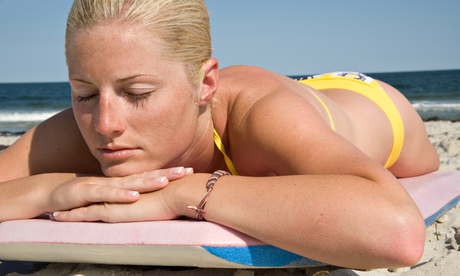
If you think a high-factor sunscreen keeps you safe from harmful rays, you may be wrong. Research in this week's Nature shows that while factor 50 reduces the number of melanomas and delays their onset, it can't prevent them. Melanomas, which develop from uncontrolled melanocyte cells (these make melanin, the pigment that darkens skin) are the most aggressive skin cancers. You have a higher risk if you have lots of moles, red or blond hair, fair skin, blue or green eyes, sunburn easily, or if a close relative has had one. Melanomas are more common if you have intermittent intense exposure to the sun – think sunburn during a week in southern Spain. Other skin cancers, such as the squamous type (the flat outer layer of skin cells) are increasingly likely with long-term exposure.
The Nature study was carried out on mice, who were given a gene mutation called Braf, found in half of melanomas in humans. But mice are small and furry – how much can we extrapolate these findings to humans?
The solution
There is continuing debate as to how effective sunscreen is in reducing melanomas – the evidence is weaker than it is for preventing squamous cell skin cancer. A 2011 Australian study of 1,621 people found that people randomly allocated to apply sunscreen daily had half the rate of melanomas of people who used cream as needed (11 in the daily group versus 22). Another study, comparing 1,167 people with melanomas to 1,101 who didn't have the cancer, found that using sunscreen routinely, alongside other protection such as hats, long sleeves or staying in the shade, did give some protection. This study, in Cancer Epidemiology, Biomarkers & Prevention, said other forms of sun protection – not sunscreen – seemed most beneficial. The study relied on people remembering what they had done over each decade of their lives and used a questionnaire that wasn't independently validated, so it's not entirely reliable. But it seems reasonable to think sunscreen gives people a false sense of security in the sun.
Many people also don't use sunscreen properly – applying insufficient amounts, failing to reapply after a couple of hours and staying in the sun too long. It is sunburn that is most worrying – recent research shows five episodes of sunburn (as in red skin with blistering) in the teenage years increases the risk of all skin cancers.
The good news is that a combination of sunscreen and covering up can reduce melanoma rates, as shown by Australian figures from their slip, slop, slap campaign. So if there is a heatwave this summer, it would be best for us, too, to slip on a shirt, slop on sunscreen and slap on a hat.

